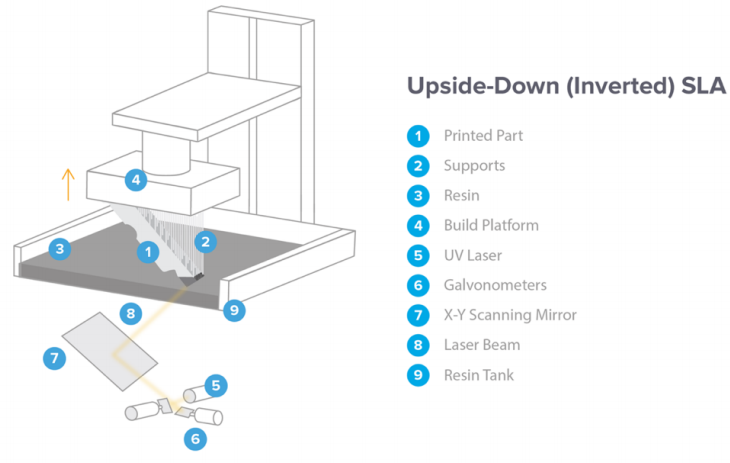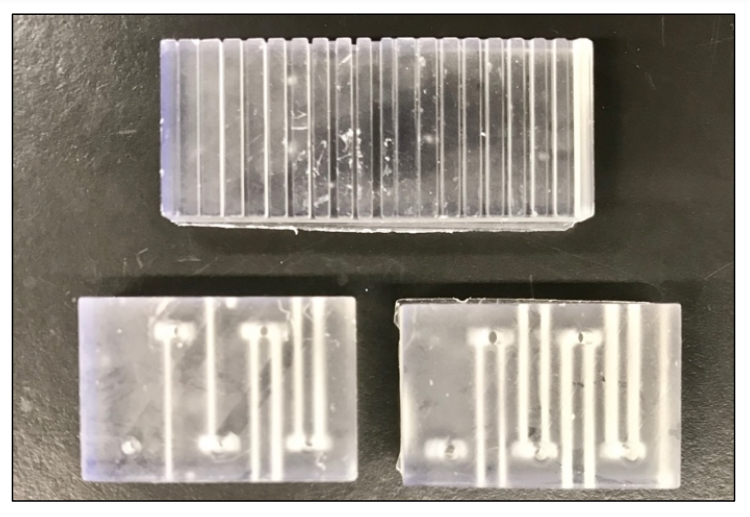Furthering STEM Education: Thesis Student 3D Prints Micro & Millifluidic Devices on a Desktop Machine
 In ‘Use of stereolithographic 3D printing for fabrication of micro and millifluidic devices for undergraduate engineering studies,’ University of Tennessee at Chattanooga thesis student Cooper Thome explores the importance of STEM studies in higher education. His work aims to find ways to provide undergraduate students in chemistry, biology, and other majors greater education in STEM learning, along with 3D printed micro and millifluidic devices for experimenting and coursework.
In ‘Use of stereolithographic 3D printing for fabrication of micro and millifluidic devices for undergraduate engineering studies,’ University of Tennessee at Chattanooga thesis student Cooper Thome explores the importance of STEM studies in higher education. His work aims to find ways to provide undergraduate students in chemistry, biology, and other majors greater education in STEM learning, along with 3D printed micro and millifluidic devices for experimenting and coursework.
Many students do not have access to such devices simply because of budgeting and manufacturing demands. 3D printing, however, offers both affordability and accessibility with the use of a Formlabs Form1+ SLA printer. Here, the researchers initially considered creating microreactors for use in biodiesel production:
“As we worked to create devices for biodiesel production, we determined that the 3D printing of micro and millifluidic devices could have a wide range of applications at the University of Tennessee at Chattanooga (UTC),” stated Thome. “Instead of focusing strictly on biodiesel production, our final focus shifted and expanded to demonstrating proof-of-concept for the use of SLA 3D printing for the production of micro and millifluidic devices with various potential applications in education and research at UTC.”
STEM education, while also invaluable in the younger grades too, has been found to offer great benefit to college students, with previous research showing higher graduation rates along with better retention in classwork too for students who participated in undergraduate research experiences (UREs). Students also showed added success in exam scores in related work due to the hands-on, active learning.
The 3D printed devices were intended to show three different types of applications to participating students interested in coursework associated with engineering:
- Laminar flow and fluid mixing
- Biodiesel production
- Droplet generation
The researchers used AutoCAD software for all modeling, allowing for control in creating device channels, ports, and bodies. While Formlabs 3D printers usually cost around $3500 retail—a price that may seem high for the average consumer—Thome explains that is a moderate expense in a commercial or lab atmosphere, and especially for production of micro and millifluidic devices.
The researchers experimented with laminar flow and fluid mixing, along with a similar device for biodiesel production. They also used a droplet generator to experiment with different sizes for fabrication. Thome states that all the techniques used were suitable for use in undergraduate studies, both in engineering and research.
“Overall, this study successfully demonstrated proof-of-concept for the use of SLA 3D printing for the production of micro and millifluidic devices intended for fluid mixing, biodiesel production, and droplet generation studies at UTC and beyond,” concluded Thome.
“In terms of education, videos depicting laminar flow, diffusive mixing, and droplet generation may be created for use in engineering lecture courses. Hands-on experiments could also be developed to complement this lecture material in associated laboratory courses. Feasible target courses include: fluid mechanics and fluid mechanics laboratory, chemical process principles and unit operations laboratory, and chemical process operations and chemical processes laboratory. Current researchers at UTC in bioengineering may also seek to incorporate this technology into undergraduate research projects. By creating hands-on experiments involving these 3D printed devices, UTC student success, confidence, and retention could be positively impacted.”
SLA is one of the oldest types of 3D printing, but still leading for innovation and fabrication in the high-tech world, from using short fiber composites and multi-materials to creating components like continuous flow microreactors. STEAM education is also consistently coming to the forefront today as manufacturers begin encouraging activity in the lower grades too by giving them 3D printing technology, such as XYZPrinting, the Taiwanese company that just invested over $1 million for US STEAM education projects, donating over 300 3D printers to different schools.
[Source / Images: Use of stereolithographic 3D printing for fabrication of micro and millifluidic devices for undergraduate engineering studies]Subscribe to Our Email Newsletter
Stay up-to-date on all the latest news from the 3D printing industry and receive information and offers from third party vendors.
You May Also Like
Gorilla Sports GE’s First 3D Printed Titanium Cast
How do you help a gorilla with a broken arm? Sounds like the start of a bad joke a zookeeper might tell, but it’s an actual dilemma recently faced by...
Nylon 3D Printed Parts Made More Functional with Coatings & Colors
Parts 3D printed from polyamide (PA, Nylon) 12 using powder bed fusion (PBF) are a mainstay in the additive manufacturing (AM) industry. While post-finishing processes have improved the porosity of...
$25M to Back Sintavia’s Largest Expansion of Metal 3D Printing Capacity Since 2019
Sintavia, the digital manufacturing company specializing in mission-critical parts for strategic sectors, announced a $25 million investment to increase its production capacity, the largest expansion to its operations since 2019....
Velo3D Initiates Public Offering in a Bid to Strengthen Financial Foundations and Drive Future Growth
Velo3D (NYSE: VLD) has been among a number of publicly traded 3D printing firms that have attempted to weather the current macroeconomic climate. After posting a challenging financial report for 2023,...


































